Cloud Computing Security and Privacy
VerifiedAdded on 2020/11/23
|7
|1870
|364
Literature Review
AI Summary
This assignment delves into the world of cloud computing, examining its various models (private, public, hybrid) and service types (SaaS, PaaS, IaaS). It emphasizes the crucial aspects of security and privacy in cloud environments, outlining techniques like encryption, data backup, strong passwords, and policy frameworks to safeguard sensitive information.
Contribute Materials
Your contribution can guide someone’s learning journey. Share your
documents today.
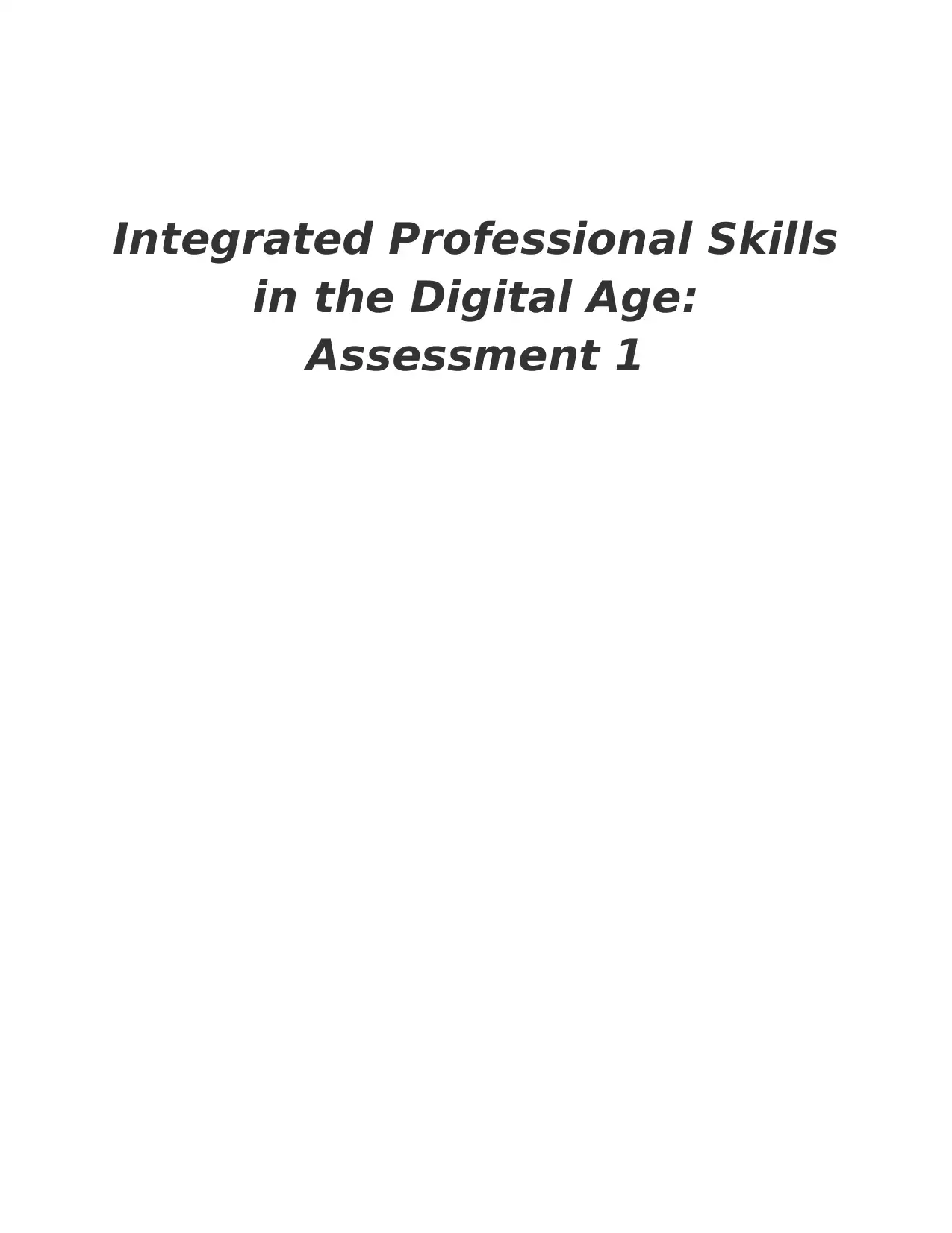
Integrated Professional Skills
in the Digital Age:
Assessment 1
in the Digital Age:
Assessment 1
Secure Best Marks with AI Grader
Need help grading? Try our AI Grader for instant feedback on your assignments.
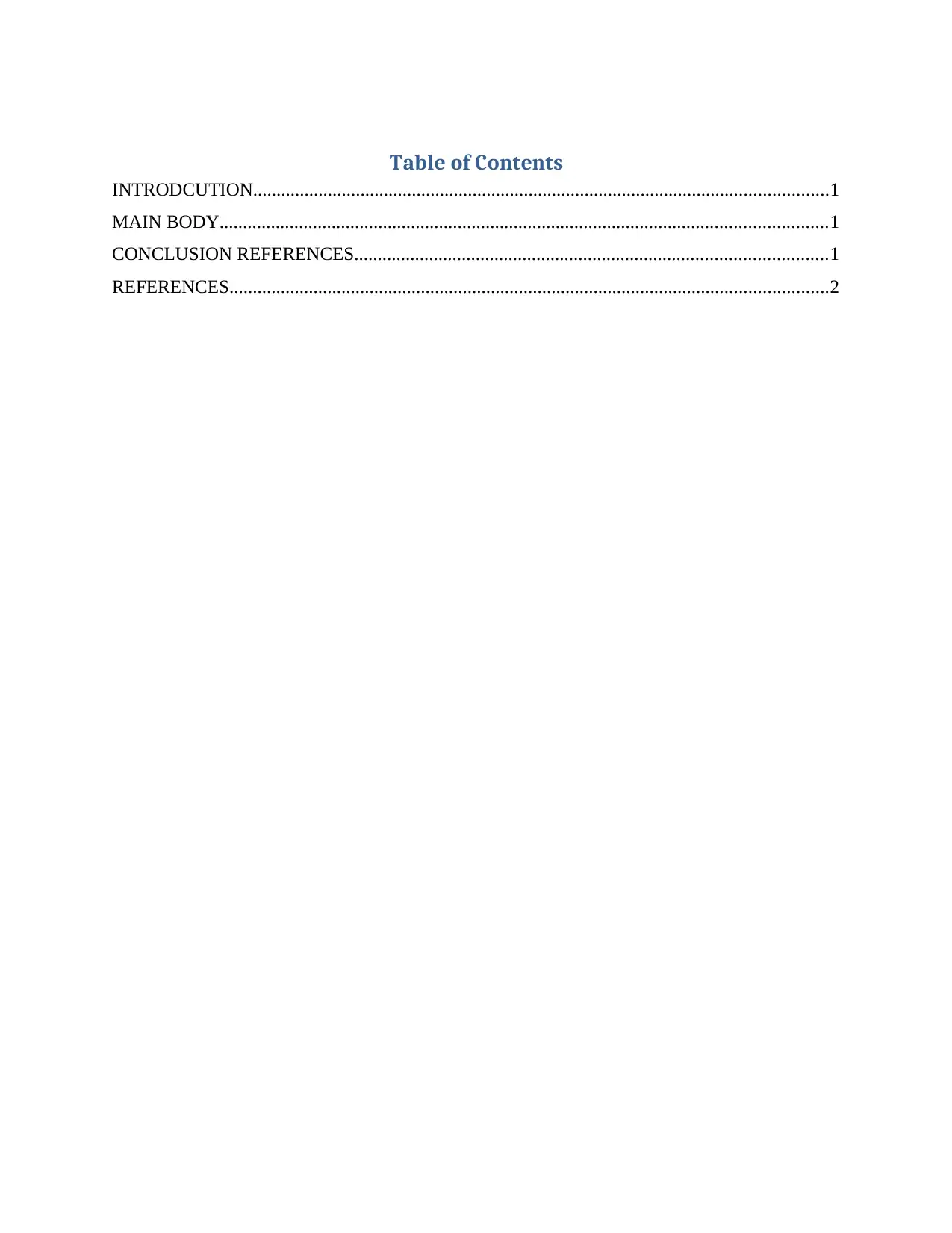
Table of Contents
INTRODCUTION...........................................................................................................................1
MAIN BODY..................................................................................................................................1
CONCLUSION REFERENCES.....................................................................................................1
REFERENCES................................................................................................................................2
INTRODCUTION...........................................................................................................................1
MAIN BODY..................................................................................................................................1
CONCLUSION REFERENCES.....................................................................................................1
REFERENCES................................................................................................................................2
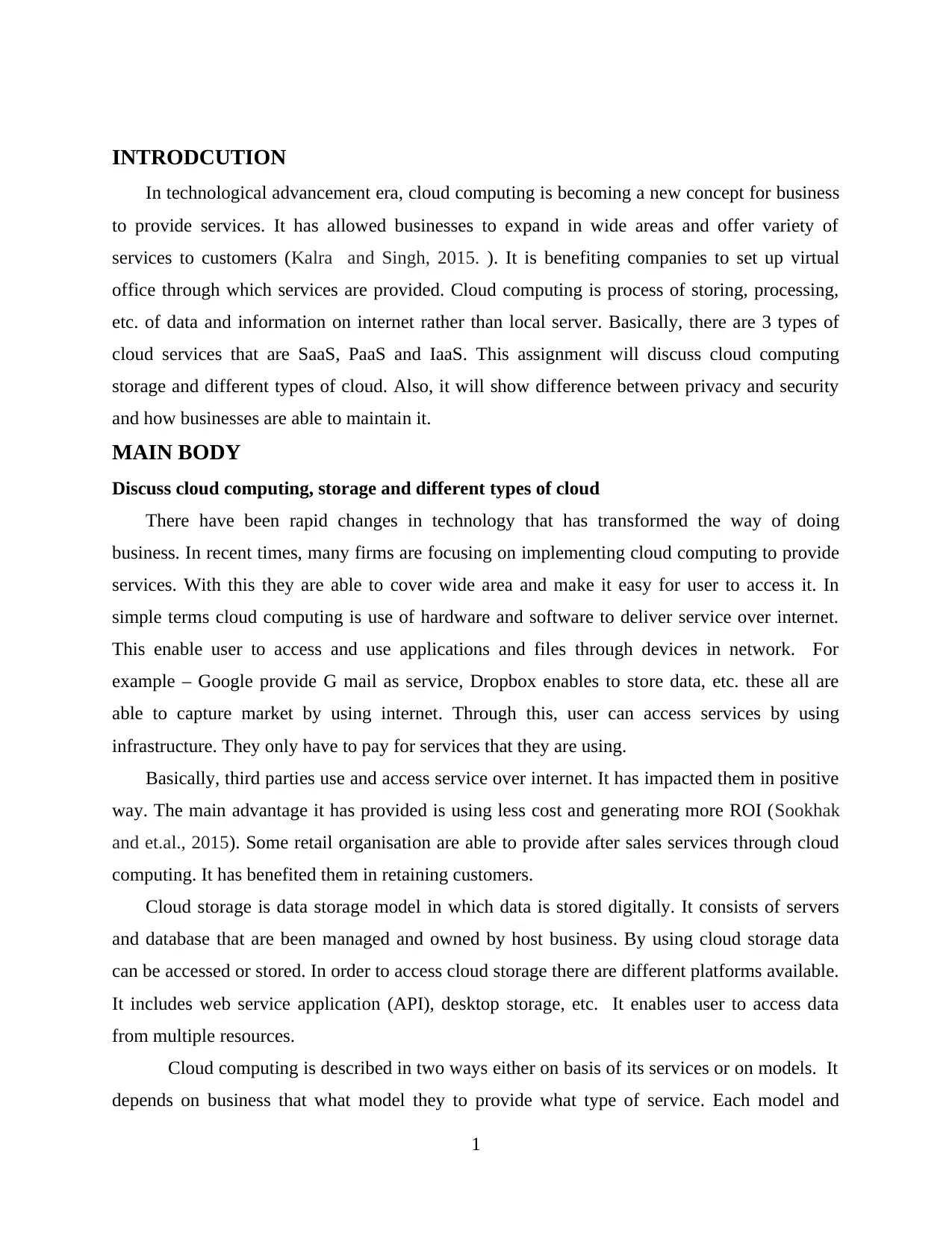
INTRODCUTION
In technological advancement era, cloud computing is becoming a new concept for business
to provide services. It has allowed businesses to expand in wide areas and offer variety of
services to customers (Kalra and Singh, 2015. ). It is benefiting companies to set up virtual
office through which services are provided. Cloud computing is process of storing, processing,
etc. of data and information on internet rather than local server. Basically, there are 3 types of
cloud services that are SaaS, PaaS and IaaS. This assignment will discuss cloud computing
storage and different types of cloud. Also, it will show difference between privacy and security
and how businesses are able to maintain it.
MAIN BODY
Discuss cloud computing, storage and different types of cloud
There have been rapid changes in technology that has transformed the way of doing
business. In recent times, many firms are focusing on implementing cloud computing to provide
services. With this they are able to cover wide area and make it easy for user to access it. In
simple terms cloud computing is use of hardware and software to deliver service over internet.
This enable user to access and use applications and files through devices in network. For
example – Google provide G mail as service, Dropbox enables to store data, etc. these all are
able to capture market by using internet. Through this, user can access services by using
infrastructure. They only have to pay for services that they are using.
Basically, third parties use and access service over internet. It has impacted them in positive
way. The main advantage it has provided is using less cost and generating more ROI (Sookhak
and et.al., 2015). Some retail organisation are able to provide after sales services through cloud
computing. It has benefited them in retaining customers.
Cloud storage is data storage model in which data is stored digitally. It consists of servers
and database that are been managed and owned by host business. By using cloud storage data
can be accessed or stored. In order to access cloud storage there are different platforms available.
It includes web service application (API), desktop storage, etc. It enables user to access data
from multiple resources.
Cloud computing is described in two ways either on basis of its services or on models. It
depends on business that what model they to provide what type of service. Each model and
1
In technological advancement era, cloud computing is becoming a new concept for business
to provide services. It has allowed businesses to expand in wide areas and offer variety of
services to customers (Kalra and Singh, 2015. ). It is benefiting companies to set up virtual
office through which services are provided. Cloud computing is process of storing, processing,
etc. of data and information on internet rather than local server. Basically, there are 3 types of
cloud services that are SaaS, PaaS and IaaS. This assignment will discuss cloud computing
storage and different types of cloud. Also, it will show difference between privacy and security
and how businesses are able to maintain it.
MAIN BODY
Discuss cloud computing, storage and different types of cloud
There have been rapid changes in technology that has transformed the way of doing
business. In recent times, many firms are focusing on implementing cloud computing to provide
services. With this they are able to cover wide area and make it easy for user to access it. In
simple terms cloud computing is use of hardware and software to deliver service over internet.
This enable user to access and use applications and files through devices in network. For
example – Google provide G mail as service, Dropbox enables to store data, etc. these all are
able to capture market by using internet. Through this, user can access services by using
infrastructure. They only have to pay for services that they are using.
Basically, third parties use and access service over internet. It has impacted them in positive
way. The main advantage it has provided is using less cost and generating more ROI (Sookhak
and et.al., 2015). Some retail organisation are able to provide after sales services through cloud
computing. It has benefited them in retaining customers.
Cloud storage is data storage model in which data is stored digitally. It consists of servers
and database that are been managed and owned by host business. By using cloud storage data
can be accessed or stored. In order to access cloud storage there are different platforms available.
It includes web service application (API), desktop storage, etc. It enables user to access data
from multiple resources.
Cloud computing is described in two ways either on basis of its services or on models. It
depends on business that what model they to provide what type of service. Each model and
1
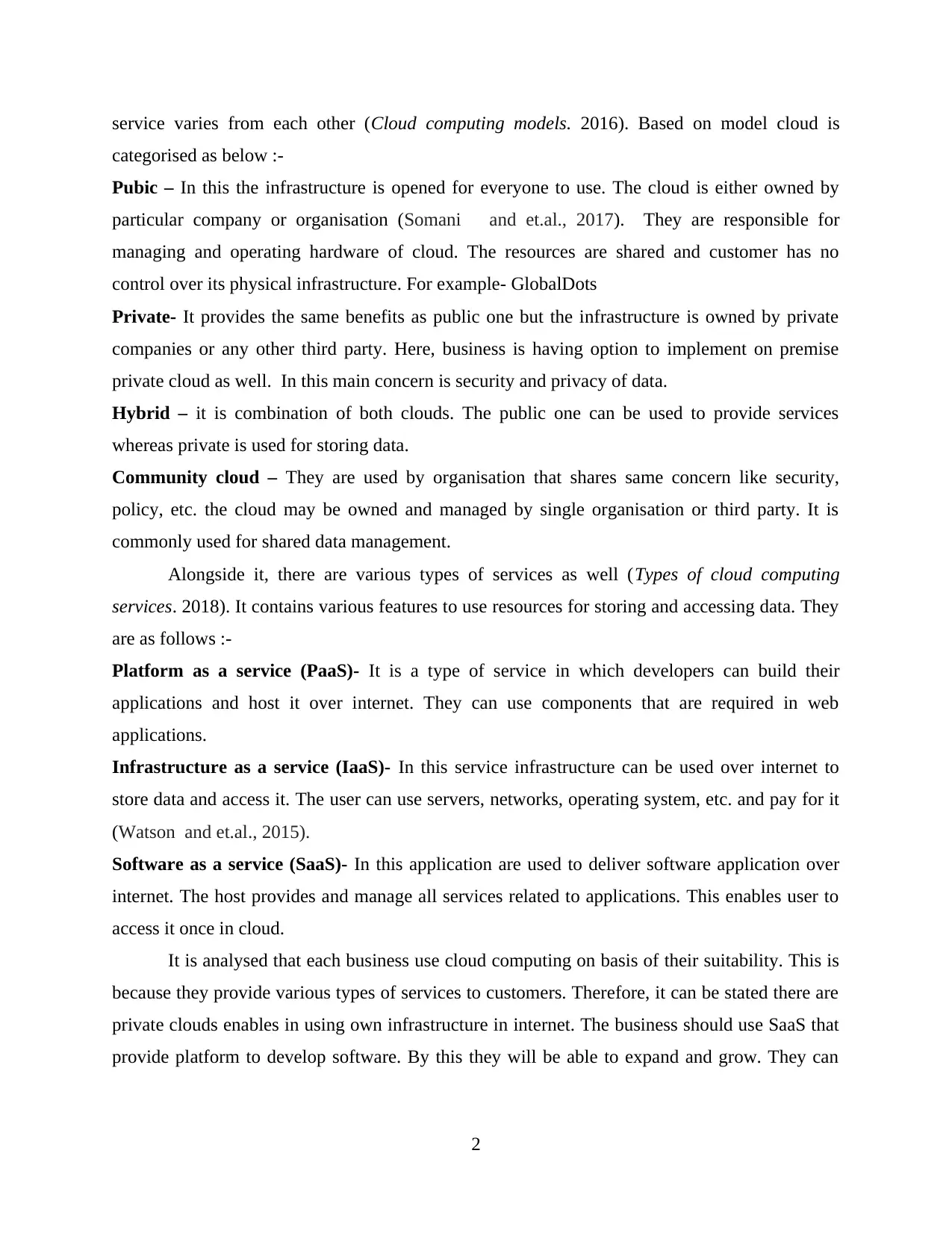
service varies from each other (Cloud computing models. 2016). Based on model cloud is
categorised as below :-
Pubic – In this the infrastructure is opened for everyone to use. The cloud is either owned by
particular company or organisation (Somani and et.al., 2017). They are responsible for
managing and operating hardware of cloud. The resources are shared and customer has no
control over its physical infrastructure. For example- GlobalDots
Private- It provides the same benefits as public one but the infrastructure is owned by private
companies or any other third party. Here, business is having option to implement on premise
private cloud as well. In this main concern is security and privacy of data.
Hybrid – it is combination of both clouds. The public one can be used to provide services
whereas private is used for storing data.
Community cloud – They are used by organisation that shares same concern like security,
policy, etc. the cloud may be owned and managed by single organisation or third party. It is
commonly used for shared data management.
Alongside it, there are various types of services as well (Types of cloud computing
services. 2018). It contains various features to use resources for storing and accessing data. They
are as follows :-
Platform as a service (PaaS)- It is a type of service in which developers can build their
applications and host it over internet. They can use components that are required in web
applications.
Infrastructure as a service (IaaS)- In this service infrastructure can be used over internet to
store data and access it. The user can use servers, networks, operating system, etc. and pay for it
(Watson and et.al., 2015).
Software as a service (SaaS)- In this application are used to deliver software application over
internet. The host provides and manage all services related to applications. This enables user to
access it once in cloud.
It is analysed that each business use cloud computing on basis of their suitability. This is
because they provide various types of services to customers. Therefore, it can be stated there are
private clouds enables in using own infrastructure in internet. The business should use SaaS that
provide platform to develop software. By this they will be able to expand and grow. They can
2
categorised as below :-
Pubic – In this the infrastructure is opened for everyone to use. The cloud is either owned by
particular company or organisation (Somani and et.al., 2017). They are responsible for
managing and operating hardware of cloud. The resources are shared and customer has no
control over its physical infrastructure. For example- GlobalDots
Private- It provides the same benefits as public one but the infrastructure is owned by private
companies or any other third party. Here, business is having option to implement on premise
private cloud as well. In this main concern is security and privacy of data.
Hybrid – it is combination of both clouds. The public one can be used to provide services
whereas private is used for storing data.
Community cloud – They are used by organisation that shares same concern like security,
policy, etc. the cloud may be owned and managed by single organisation or third party. It is
commonly used for shared data management.
Alongside it, there are various types of services as well (Types of cloud computing
services. 2018). It contains various features to use resources for storing and accessing data. They
are as follows :-
Platform as a service (PaaS)- It is a type of service in which developers can build their
applications and host it over internet. They can use components that are required in web
applications.
Infrastructure as a service (IaaS)- In this service infrastructure can be used over internet to
store data and access it. The user can use servers, networks, operating system, etc. and pay for it
(Watson and et.al., 2015).
Software as a service (SaaS)- In this application are used to deliver software application over
internet. The host provides and manage all services related to applications. This enables user to
access it once in cloud.
It is analysed that each business use cloud computing on basis of their suitability. This is
because they provide various types of services to customers. Therefore, it can be stated there are
private clouds enables in using own infrastructure in internet. The business should use SaaS that
provide platform to develop software. By this they will be able to expand and grow. They can
2
Secure Best Marks with AI Grader
Need help grading? Try our AI Grader for instant feedback on your assignments.
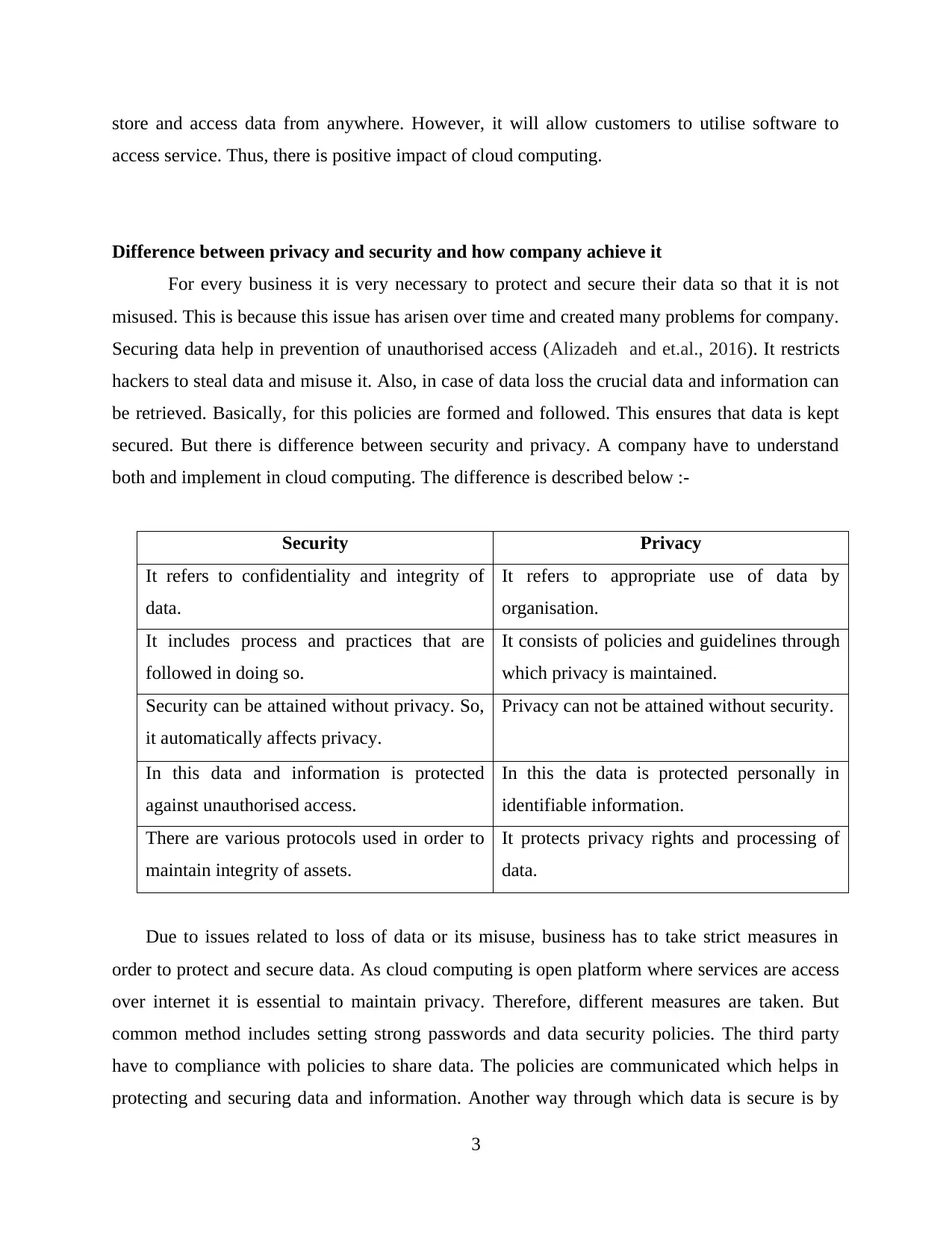
store and access data from anywhere. However, it will allow customers to utilise software to
access service. Thus, there is positive impact of cloud computing.
Difference between privacy and security and how company achieve it
For every business it is very necessary to protect and secure their data so that it is not
misused. This is because this issue has arisen over time and created many problems for company.
Securing data help in prevention of unauthorised access (Alizadeh and et.al., 2016). It restricts
hackers to steal data and misuse it. Also, in case of data loss the crucial data and information can
be retrieved. Basically, for this policies are formed and followed. This ensures that data is kept
secured. But there is difference between security and privacy. A company have to understand
both and implement in cloud computing. The difference is described below :-
Security Privacy
It refers to confidentiality and integrity of
data.
It refers to appropriate use of data by
organisation.
It includes process and practices that are
followed in doing so.
It consists of policies and guidelines through
which privacy is maintained.
Security can be attained without privacy. So,
it automatically affects privacy.
Privacy can not be attained without security.
In this data and information is protected
against unauthorised access.
In this the data is protected personally in
identifiable information.
There are various protocols used in order to
maintain integrity of assets.
It protects privacy rights and processing of
data.
Due to issues related to loss of data or its misuse, business has to take strict measures in
order to protect and secure data. As cloud computing is open platform where services are access
over internet it is essential to maintain privacy. Therefore, different measures are taken. But
common method includes setting strong passwords and data security policies. The third party
have to compliance with policies to share data. The policies are communicated which helps in
protecting and securing data and information. Another way through which data is secure is by
3
access service. Thus, there is positive impact of cloud computing.
Difference between privacy and security and how company achieve it
For every business it is very necessary to protect and secure their data so that it is not
misused. This is because this issue has arisen over time and created many problems for company.
Securing data help in prevention of unauthorised access (Alizadeh and et.al., 2016). It restricts
hackers to steal data and misuse it. Also, in case of data loss the crucial data and information can
be retrieved. Basically, for this policies are formed and followed. This ensures that data is kept
secured. But there is difference between security and privacy. A company have to understand
both and implement in cloud computing. The difference is described below :-
Security Privacy
It refers to confidentiality and integrity of
data.
It refers to appropriate use of data by
organisation.
It includes process and practices that are
followed in doing so.
It consists of policies and guidelines through
which privacy is maintained.
Security can be attained without privacy. So,
it automatically affects privacy.
Privacy can not be attained without security.
In this data and information is protected
against unauthorised access.
In this the data is protected personally in
identifiable information.
There are various protocols used in order to
maintain integrity of assets.
It protects privacy rights and processing of
data.
Due to issues related to loss of data or its misuse, business has to take strict measures in
order to protect and secure data. As cloud computing is open platform where services are access
over internet it is essential to maintain privacy. Therefore, different measures are taken. But
common method includes setting strong passwords and data security policies. The third party
have to compliance with policies to share data. The policies are communicated which helps in
protecting and securing data and information. Another way through which data is secure is by
3
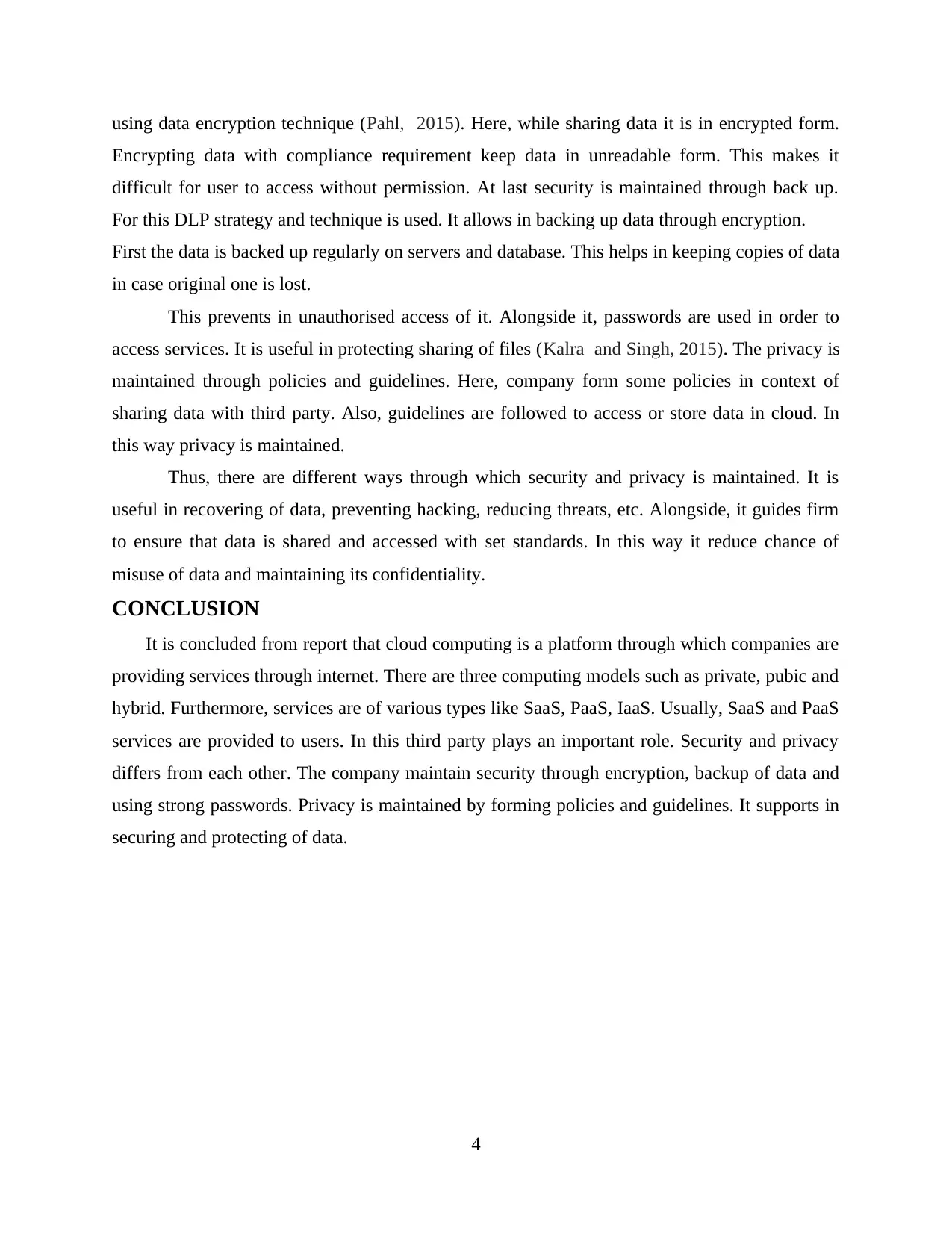
using data encryption technique (Pahl, 2015). Here, while sharing data it is in encrypted form.
Encrypting data with compliance requirement keep data in unreadable form. This makes it
difficult for user to access without permission. At last security is maintained through back up.
For this DLP strategy and technique is used. It allows in backing up data through encryption.
First the data is backed up regularly on servers and database. This helps in keeping copies of data
in case original one is lost.
This prevents in unauthorised access of it. Alongside it, passwords are used in order to
access services. It is useful in protecting sharing of files (Kalra and Singh, 2015). The privacy is
maintained through policies and guidelines. Here, company form some policies in context of
sharing data with third party. Also, guidelines are followed to access or store data in cloud. In
this way privacy is maintained.
Thus, there are different ways through which security and privacy is maintained. It is
useful in recovering of data, preventing hacking, reducing threats, etc. Alongside, it guides firm
to ensure that data is shared and accessed with set standards. In this way it reduce chance of
misuse of data and maintaining its confidentiality.
CONCLUSION
It is concluded from report that cloud computing is a platform through which companies are
providing services through internet. There are three computing models such as private, pubic and
hybrid. Furthermore, services are of various types like SaaS, PaaS, IaaS. Usually, SaaS and PaaS
services are provided to users. In this third party plays an important role. Security and privacy
differs from each other. The company maintain security through encryption, backup of data and
using strong passwords. Privacy is maintained by forming policies and guidelines. It supports in
securing and protecting of data.
4
Encrypting data with compliance requirement keep data in unreadable form. This makes it
difficult for user to access without permission. At last security is maintained through back up.
For this DLP strategy and technique is used. It allows in backing up data through encryption.
First the data is backed up regularly on servers and database. This helps in keeping copies of data
in case original one is lost.
This prevents in unauthorised access of it. Alongside it, passwords are used in order to
access services. It is useful in protecting sharing of files (Kalra and Singh, 2015). The privacy is
maintained through policies and guidelines. Here, company form some policies in context of
sharing data with third party. Also, guidelines are followed to access or store data in cloud. In
this way privacy is maintained.
Thus, there are different ways through which security and privacy is maintained. It is
useful in recovering of data, preventing hacking, reducing threats, etc. Alongside, it guides firm
to ensure that data is shared and accessed with set standards. In this way it reduce chance of
misuse of data and maintaining its confidentiality.
CONCLUSION
It is concluded from report that cloud computing is a platform through which companies are
providing services through internet. There are three computing models such as private, pubic and
hybrid. Furthermore, services are of various types like SaaS, PaaS, IaaS. Usually, SaaS and PaaS
services are provided to users. In this third party plays an important role. Security and privacy
differs from each other. The company maintain security through encryption, backup of data and
using strong passwords. Privacy is maintained by forming policies and guidelines. It supports in
securing and protecting of data.
4
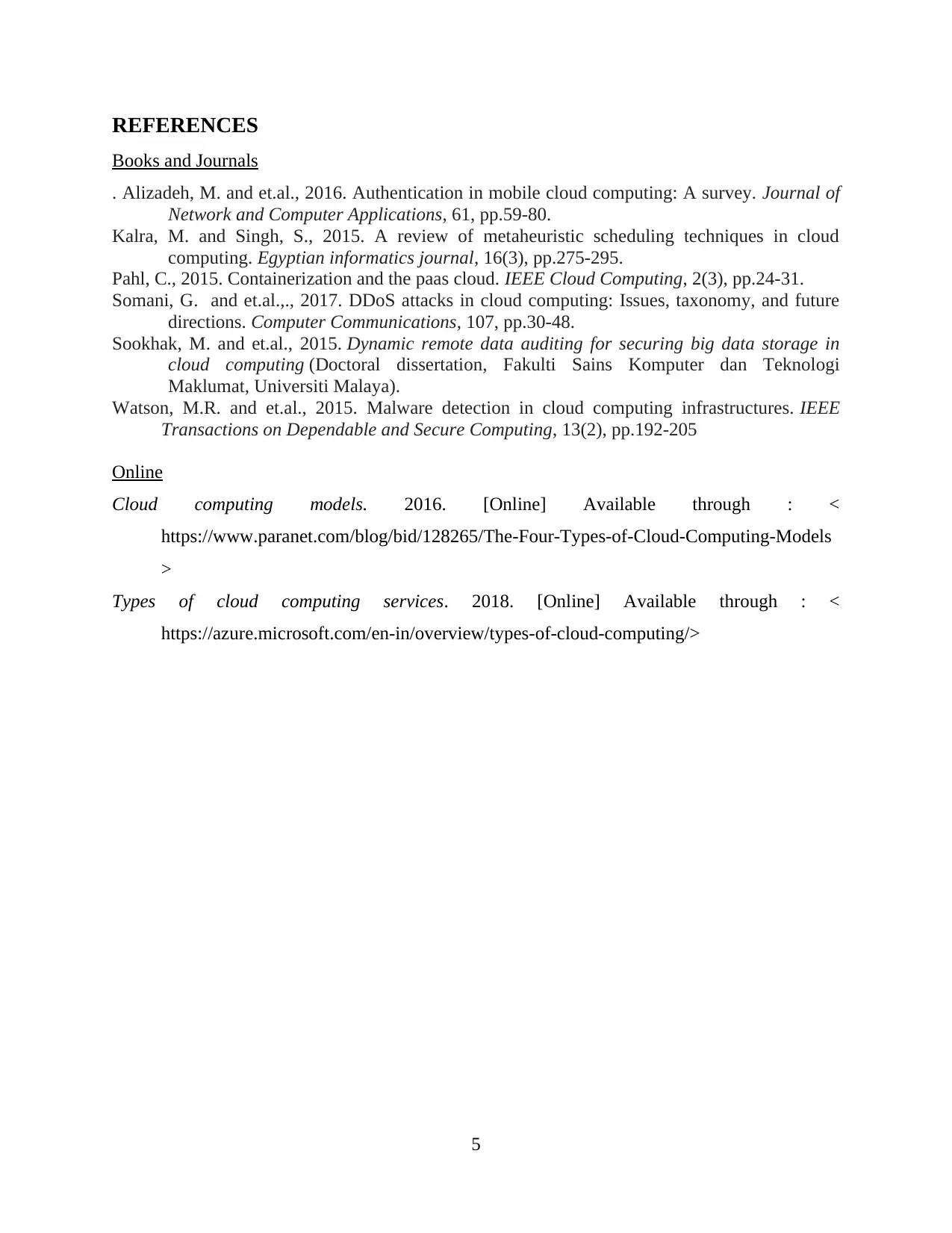
REFERENCES
Books and Journals
. Alizadeh, M. and et.al., 2016. Authentication in mobile cloud computing: A survey. Journal of
Network and Computer Applications, 61, pp.59-80.
Kalra, M. and Singh, S., 2015. A review of metaheuristic scheduling techniques in cloud
computing. Egyptian informatics journal, 16(3), pp.275-295.
Pahl, C., 2015. Containerization and the paas cloud. IEEE Cloud Computing, 2(3), pp.24-31.
Somani, G. and et.al.,., 2017. DDoS attacks in cloud computing: Issues, taxonomy, and future
directions. Computer Communications, 107, pp.30-48.
Sookhak, M. and et.al., 2015. Dynamic remote data auditing for securing big data storage in
cloud computing (Doctoral dissertation, Fakulti Sains Komputer dan Teknologi
Maklumat, Universiti Malaya).
Watson, M.R. and et.al., 2015. Malware detection in cloud computing infrastructures. IEEE
Transactions on Dependable and Secure Computing, 13(2), pp.192-205
Online
Cloud computing models. 2016. [Online] Available through : <
https://www.paranet.com/blog/bid/128265/The-Four-Types-of-Cloud-Computing-Models
>
Types of cloud computing services. 2018. [Online] Available through : <
https://azure.microsoft.com/en-in/overview/types-of-cloud-computing/>
5
Books and Journals
. Alizadeh, M. and et.al., 2016. Authentication in mobile cloud computing: A survey. Journal of
Network and Computer Applications, 61, pp.59-80.
Kalra, M. and Singh, S., 2015. A review of metaheuristic scheduling techniques in cloud
computing. Egyptian informatics journal, 16(3), pp.275-295.
Pahl, C., 2015. Containerization and the paas cloud. IEEE Cloud Computing, 2(3), pp.24-31.
Somani, G. and et.al.,., 2017. DDoS attacks in cloud computing: Issues, taxonomy, and future
directions. Computer Communications, 107, pp.30-48.
Sookhak, M. and et.al., 2015. Dynamic remote data auditing for securing big data storage in
cloud computing (Doctoral dissertation, Fakulti Sains Komputer dan Teknologi
Maklumat, Universiti Malaya).
Watson, M.R. and et.al., 2015. Malware detection in cloud computing infrastructures. IEEE
Transactions on Dependable and Secure Computing, 13(2), pp.192-205
Online
Cloud computing models. 2016. [Online] Available through : <
https://www.paranet.com/blog/bid/128265/The-Four-Types-of-Cloud-Computing-Models
>
Types of cloud computing services. 2018. [Online] Available through : <
https://azure.microsoft.com/en-in/overview/types-of-cloud-computing/>
5
1 out of 7
Related Documents
Your All-in-One AI-Powered Toolkit for Academic Success.
+13062052269
info@desklib.com
Available 24*7 on WhatsApp / Email
![[object Object]](/_next/static/media/star-bottom.7253800d.svg)
Unlock your academic potential
© 2024 | Zucol Services PVT LTD | All rights reserved.





